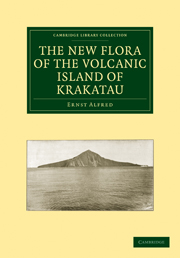Book contents
- Frontmatter
- PREFACE
- NOTE BY THE TRANSLATOR
- Contents
- PLATES
- INTRODUCTION
- I Results of the visits of 1886 and 1897
- II The Expedition of April 24—27, 1906, to the Sunda Strait region and to Krakatau
- III The present composition of the Flora of Krakatau
- IV Biological conditions on Krakatau
- V The relative importance of the different agents of plant-dispersal in the colonisation of the Krakatau Islands
- VI Succession of plant-associations and the future character of the vegetation of Krakatau
- BIBLIOGRAPHY
VI - Succession of plant-associations and the future character of the vegetation of Krakatau
Published online by Cambridge University Press: 07 September 2010
- Frontmatter
- PREFACE
- NOTE BY THE TRANSLATOR
- Contents
- PLATES
- INTRODUCTION
- I Results of the visits of 1886 and 1897
- II The Expedition of April 24—27, 1906, to the Sunda Strait region and to Krakatau
- III The present composition of the Flora of Krakatau
- IV Biological conditions on Krakatau
- V The relative importance of the different agents of plant-dispersal in the colonisation of the Krakatau Islands
- VI Succession of plant-associations and the future character of the vegetation of Krakatau
- BIBLIOGRAPHY
Summary
The comparatively advanced state of differentiation of the vegetation into plant-associations or formations is no less surprising than the remarkably large number and the variety of species in the new flora of Krakatau. As Penzig showed, the development of plantassociations had already begun in 1897. On the beach the plants of the Pes-caprae formation predominated. In the interior of the island the vegetation presented the appearance of a grass-steppe. Ferns constituted the dominant plants on the slopes of the cone. Since 1897 the aspect of the vegetation has undergone considerable change; the strand-flora is divided into two formations. An outer zone of varying breadth, reaching in places to the tide-level, consists of low creeping grasses and herbaceous plants, bushes and shrubs; the typical Pes-caprae formation. Behind this rises the strandforest (Barringtonia formation), the composition of which is not yet equal in variety of species and in gloomy grandeur to the Barringtonia strand-forests on the coasts of Java and Sumatra, nor will it soon reach the same level. Neither of these strandformations is as yet closed. Grasses, Cyperaceae, Ferns and Composites spread from the grass-steppe of the interior through clearings in the forest to the lower carpet of Ipomaea and Spinifex, while in other directions groups of strand-plants have penetrated inland for a distance of 300—500 metres. The beautiful group of coconut palms, 400 metres from the shore-line, represented in the photograph (PL VI., fig. 7, p. 30), affords an example of the latter.
- Type
- Chapter
- Information
- The New Flora of the Volcanic Island of Krakatau , pp. 68 - 72Publisher: Cambridge University PressPrint publication year: 2009First published in: 1908



